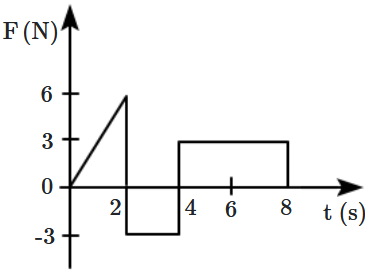Choose the incorrect alternative:
| 1. | Newton's first law is the law of inertia. |
| 2. | Newton's first law states that if the net force on a system is zero, the acceleration of any particle of the system is not zero. |
| 3. | Action and reaction act simultaneously. |
| 4. | The area under the force-time graph is equal to the change in momentum. |
If two forces \(\left(6 \hat{i}+8\hat j\right)\) and \(\left(4 \hat{i}+4\hat j \right)\)N are acting on a body of mass \(2\) kg, then the acceleration produced in the body (in \(\text{m/s}^{2}\)) will be:
1. \(\left(5 \hat{i}+6\hat j\right)\)
2. \(\left(10 \hat{i}+12\hat j\right)\)
3. \(\left(6 \hat{i}+12\hat j\right)\)
4. \(\left(2 \hat{i}+3\hat j\right)\)
A body of mass \(5\) kg is acted upon by two perpendicular forces, \(8\) N and \(6\) N. The magnitude of the acceleration of the body is:
| 1. | \(0.99\) ms-2 | 2. | \(3\) ms-2 |
| 3. | \(2\) ms-2 | 4. | \(0.77\) ms-2 |
The force \(\mathrm{F}\) acting on a particle of mass \(\mathrm{m}\) is indicated by the force-time graph shown below. The change in momentum of the particle over the time interval from \(0\) to \(8\) s is:
| 1. | \(24\) N-s | 2. | \(20\) N-s |
| 3. | \(12\) N-s | 4. | \(6\) N-s |
On the application of an impulsive force, a sphere of mass \(500\) grams starts moving with an acceleration of \(10\) m/s2. The force acts on it for \(0.5\) s. The gain in the momentum of the sphere will be:
1. \(2.5\) kg-m/s
2. \(5\) kg-m/s
3. \(0.05\) kg-m/s
4. \(25\) kg-m/s
Two masses, \(m_1\) and \(m_2\) are experiencing the same force where \(m_1<m_2\). The ratio of their acceleration \(\frac{a_{1}}{a_{2}}\) is:
1. \(1\)
2. less than \(1\)
3. greater than \(1\)
4. all the three cases
An impulse of \(6m \hat{j}\) is applied to a body of mass m moving with velocity \(\hat i+2\hat j\). The final velocity of the body will be:
1. \(-\hat i + 8\hat j\)
2. \(\hat i - 8\hat j\)
3. \(\hat i + 8\hat j\)
4. \(8\hat i - \hat j\)
A \(100\) kg gun fires a ball of \(1\) kg horizontally from a cliff at a height of \(500\) m. It falls on the ground at a distance of \(400\) m from the bottom of the cliff. The recoil velocity of the gun is: (Take \(g=10\) m/s2)
1. \(0.2\) m/s
2. \(0.4\) m/s
3. \(0.6\) m/s
4. \(0.8\) m/s
An object of mass \(3\) kg is at rest. Now if a force of \(\overrightarrow{F} = 6 t^{2} \hat{i} + 4 t \hat{j}\) is applied to the object, then the velocity of the object at \(t =3\) second will be:
1. \(18 \hat{i} + 3 \hat{j}\)
2. \(18 \hat{i} + 6 \hat{j}\)
3. \(3 \hat{i} + 18 \hat{j}\)
4. \(18 \hat{i} + 4 \hat{j}\)
A rigid ball of mass \(M\) strikes a rigid wall at \(60^{\circ}\) and gets reflected without loss of speed, as shown in the figure. The value of the impulse imparted by the wall on the ball will be:
| 1. | \(Mv\) | 2. | \(2Mv\) |
| 3. | \(\frac{Mv}{2}\) | 4. | \(\frac{Mv}{3}\) |




